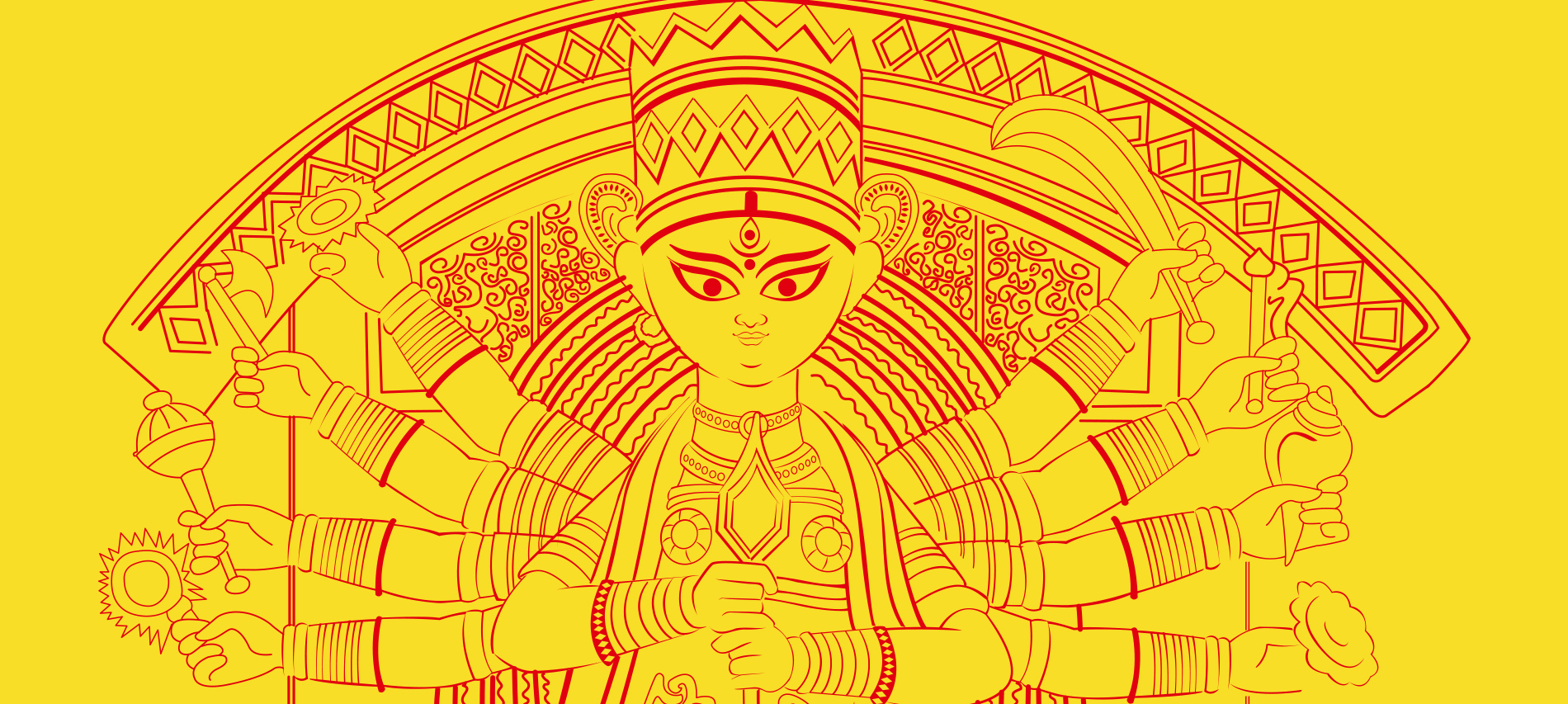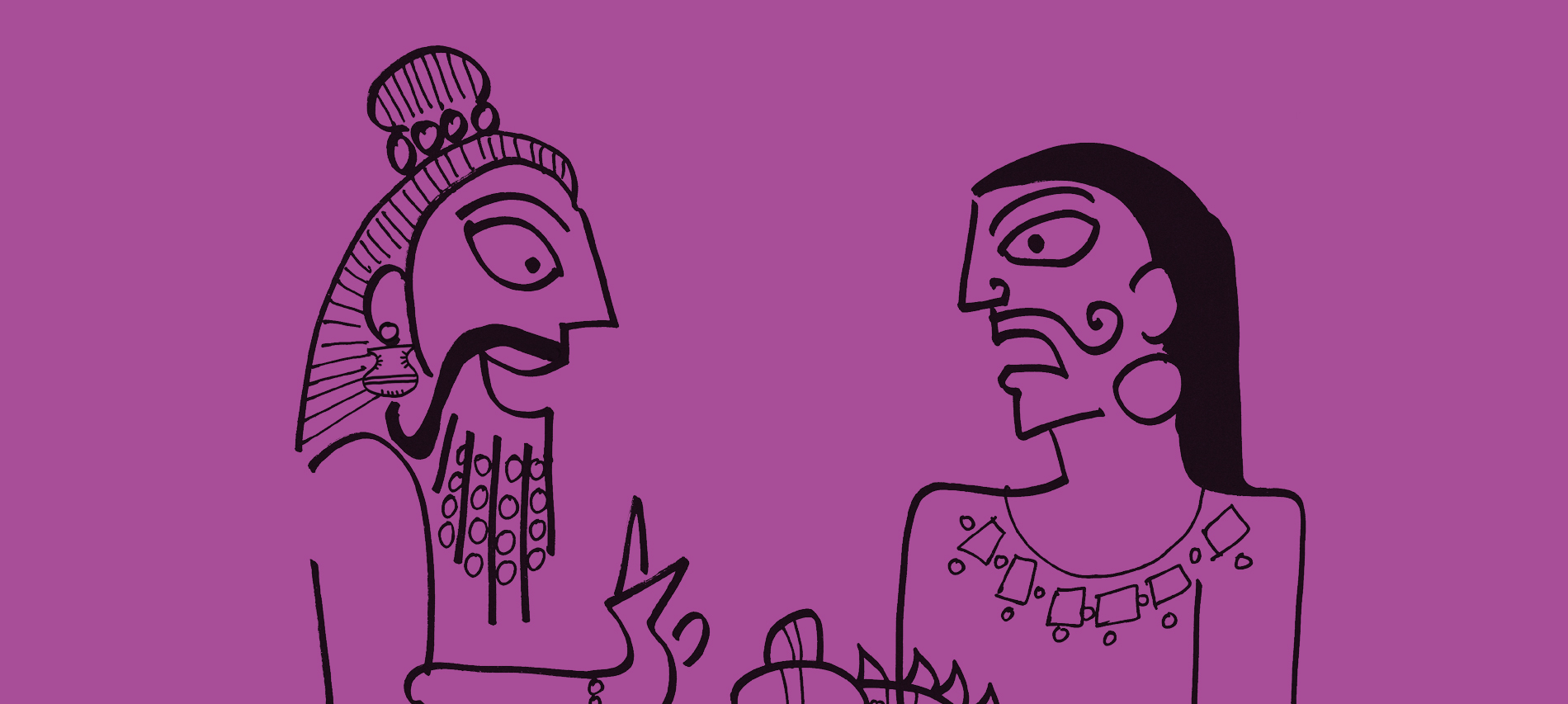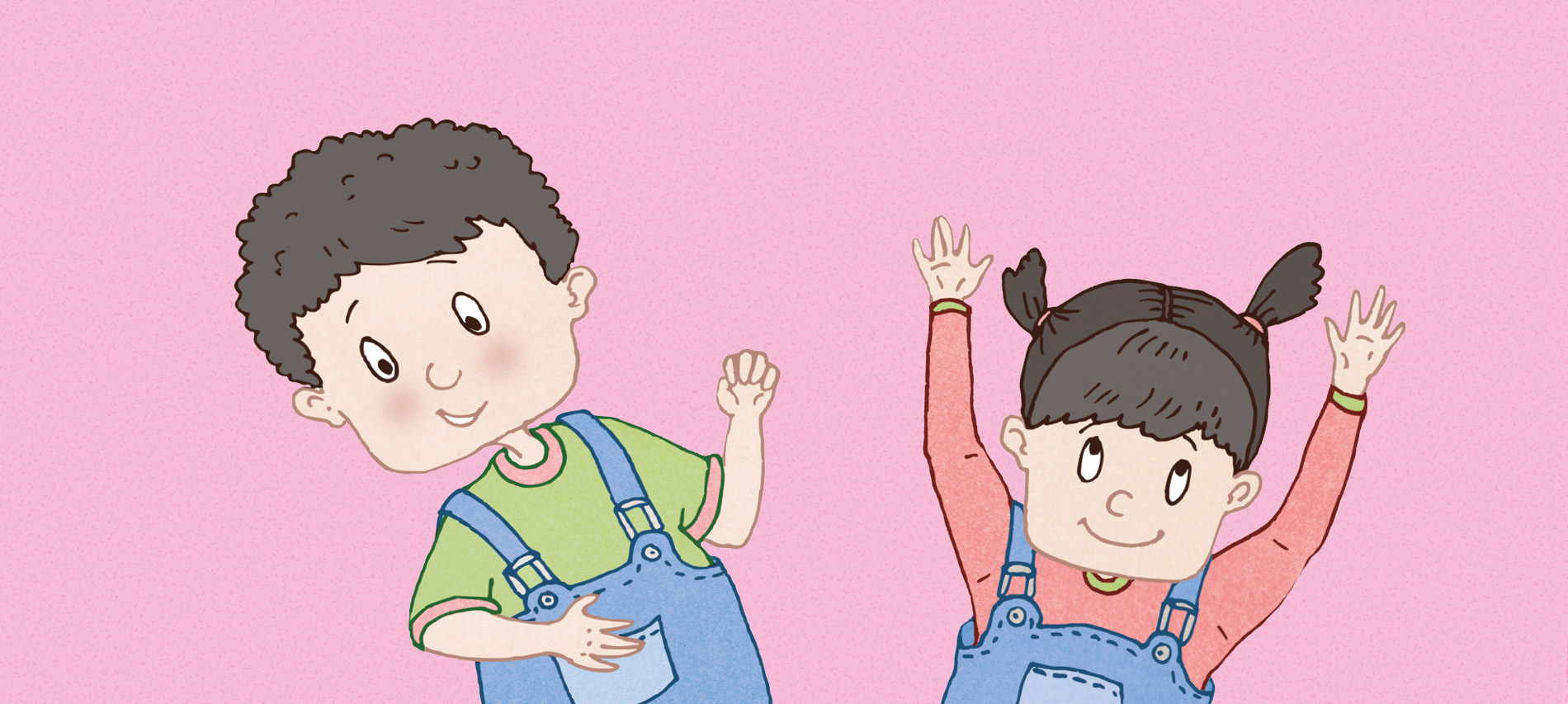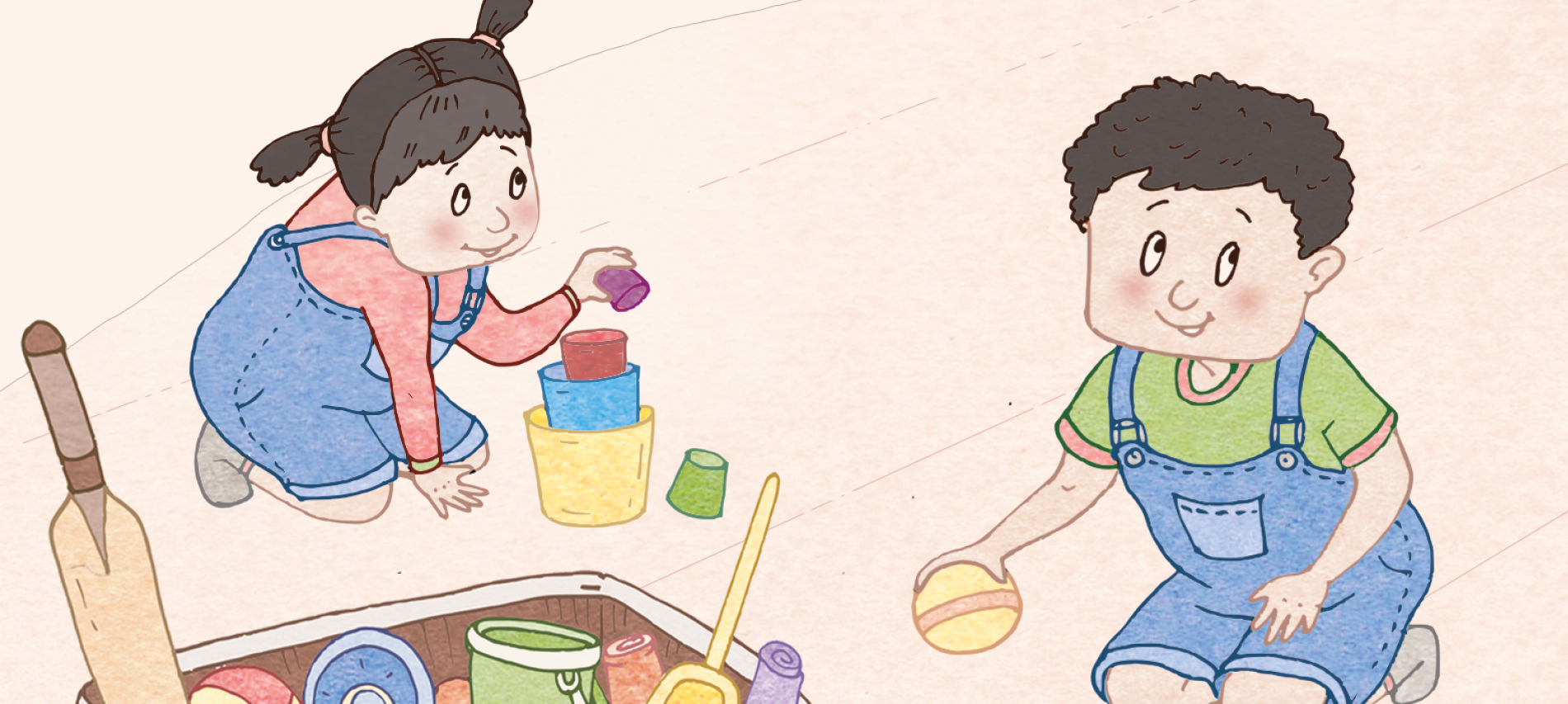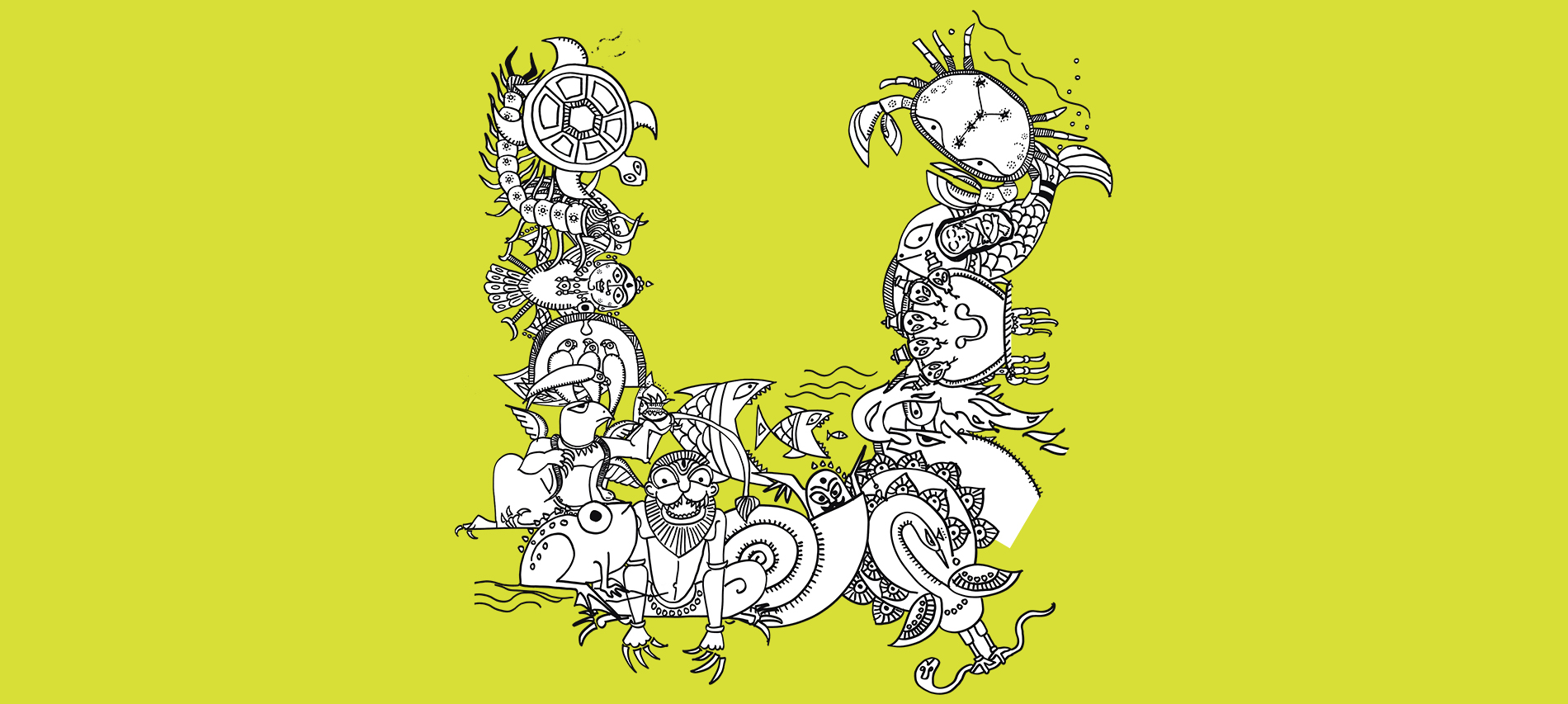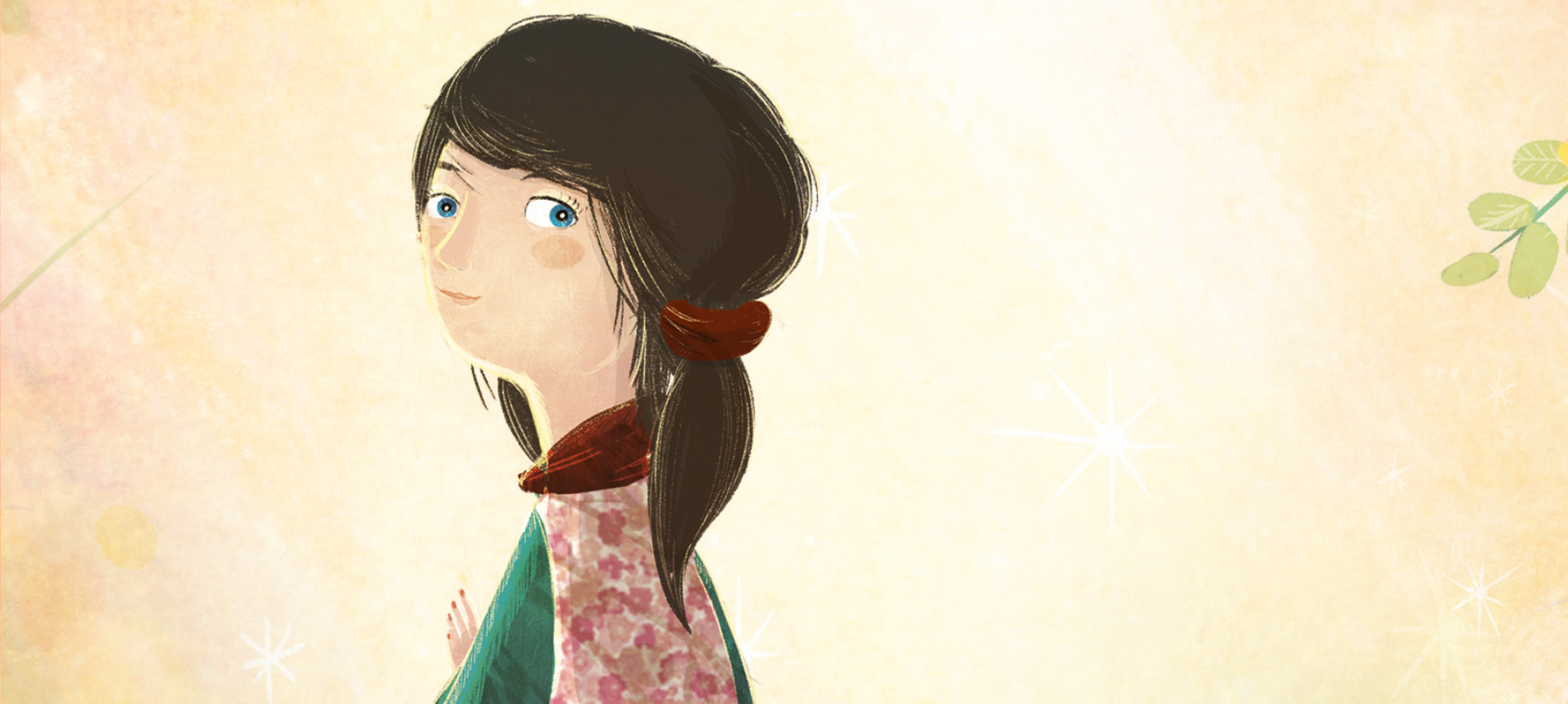In Sonia Mehta’s It’s Cool to Respect Others from her new series of books — My Book of Values, the author reminds us as to why having some values in life is totally cool!
Nicky and Noni do not seem to be too enthusiastic about visiting their grandparents. Why? What uncool things do they do which no one approves of? Let’s find out!




Do Nicky and Noni realise their mistake? Find out with It’s Cool to Respect Others!

Tag: Puffin India
Just Before We Set Off For Earth — 'Earthward Bound'
As one recovers from the heavy hearts left behind after a brilliant week of Durga Puja fun and festivities, here’s a little throwback with a short story, ‘Earthward Bound’, by writer Nayanika Mahtani, on what happens in Goddess Durga’s household just before she descends on earth with her children, ushering in a joyful autumn!
‘Come on kids, get ready – we’re off on a little journey,’ said Goddess Durga. Her four children Lakshmi, Saraswati, Kartikeya and Ganesha were busy having a snowball fight in the mountains of Kailash.
‘Where are we headed, Ma?’ asked Ganesha.
‘To Earth of course, silly!’ said Saraswati.
‘Have you forgotten – we go every year when Ma is invited by her devotees?’ said Lakshmi.
‘I knew that – obvio!’ mumbled Ganesha.
‘Yup, he would never forget the sweets at Puja,’ piped in Kartikeya.
‘Could you four please stop squabbling – we need to get there in time!’ said Ma Durga. ‘Oh, quick check – have I taken everything?’
‘Hmm, let’s see Ma,’ said Saraswati. ‘Have you got Vishnu’s discus, Shiva’s trident, Varuna’s conch and noose, Agni’s flaming dart, Vayu’s bow, Surya’s quiver full of arrows, Yama’s sword and shield, Vishwakarma’s axe and armour and Indra’s thunderbolt?’
‘Whoa! That’s quite a handful – good thing you have so many hands, Ma!’ said Ganesha. ‘How come you get to keep all the weapons that the Gods gave you to fight Mahishasur – even though he is now long dead?’
‘Well, Mahishasur may be dead but evil lives on, Ganesha – and I always need to be ready to fight evil,’ replied Ma Durga.
‘Will we be riding on the lion given to you by Himavat?’ asked Lakshmi.
‘Of course!’ said Ma Durga. ‘Now as you know the Devi Paksha rituals start from Mahalaya, when we begin our journey to Earth. Who remembers what Mahalaya means?’
‘Ahem, I do!’ said Kartikeya, casting a sideways glance at Ganesha. ‘“Maha” means ‘big’, and “laya”, means ‘destruction’. It refers to the colossal war between the Devtas, Rishis and Asuras – where many Devtas and Rishis died at the hands of the Asuras. People on Earth consider Devtas and Rishis to be their forefathers. That’s why the ritual of Tarpan or Shraddh happens on Mahalaya, when prayers are offered in remembrance.’
‘Bah! Such a show-off!’ muttered Ganesha, whose mind was now feasting on the soon-to-be-had sandesh and laddoos.
‘Though the actual Puja starts from the sixth day, the Shashthi, when we five arrive on Earth,’ added Saraswati.
‘That’s right,’ said Ma Durga. ‘It begins with Bodhan, which marks the moment when I was given all the divine arms to rid the Earth of Mahishasur’s tyranny. On Shashti, my face is uncovered – to show that I have arrived on Earth. The next day is Saptami and it starts with a ritual called “Kola Bou”.’
“Ha ha! Kola Bou’s your wife, Ganesha!’ teased Lakshmi. ‘Such a pretty banana tree stalk, bathed and draped in a white sari with a red border and placed by your side!’
‘Tsk, don’t make him blush, Lakshmi!’ chided Ma Durga. ‘Actually it is not just a banana stalk that is bathed; nine plants are placed by my Ganesha after the bathing rituals. It’s called “Nabapatrika” puja – and these nine plants represent the nine forms of Shakti, of which you are one too, my Lakshmi.’
‘I feel a bit sidelined, to be honest,’ said Saraswati.
‘Come on! You get a day all to yourself to be worshipped,’ said Kartikeya.
‘Well, you get a day like that too, Kartikeya’ said Ma Durga. ‘Anyway, let’s not get sidetracked, kids! So then follows Ashtami which is considered the most auspicious day of Durga Puja – with its most significant ritual being the Sandhi Puja.’
‘Let me elaborate,’ said Kartikeya with a flourish. ‘Sandhikshan, when Sandhi Puja is done, falls between the last 24 minutes of Ashtami and the first 24 minutes of Navami. This is the exact time when the Asuras Chanda and Munda were slain by Ma.’
‘It for this reason I am also called Chamunda,’ said Ma Durga.
‘Aarrgh! Why doesn’t our family keep just one name for each of us?’ asked Ganesha. ‘I have such a hard time keeping track of all my names. It’s so tricky figuring out when I’m being called!’
Ma Durga smiled and carried on. ‘Then comes Dashami or Vijaya Dashami which is the day I killed Mahishasura – and freed the Earth of his torments. Vijaya Dashami is the last day of the puja.’
‘And it’s also when Ma’s idol is taken to a water body and immersed, denoting her journey back to Kailash,’ said Saraswati.
‘That’s right! Well done, all of you!’ said Ma Durga. ‘Now hold on tight – we’re about to take off!’
‘Have a safe journey, family,’ boomed a deep voice in the background. He watched Ma Durga and the children fly earthwards. Lord Shiva closed his eyes. ‘Ah! Now for some peace and quiet, finally.’
Would you like to look up what each of the weapons of Goddess Durga signifies? Hindu mythology is such a treasure trove – there’s always more than what meets the eye. Look for these treasures – you won’t be disappointed!
Note: Ganesha was of course just pretending to not know all the answers in this story, to rile his Mum and siblings. He in fact is quite the know-it-all. Though he can get distracted when sweets are involved. ☺
Nayanika Mahtani is a copywriter by day and a storyteller by night. She lives in London with her husband, two daughters and their two goldfish named Sushi and Fishfinger. Nayanika has published two books with Puffin, ‘Ambushed’ and ‘The Gory Story of Genghis Khan’.
The Simple Messages Hidden in ‘Mahabharata’: ‘The Boys Who Fought’
The story of Mahabharata has been retold countless times through generations and one instinctively comes to identify it with the great battle of Kurukshetra.
But going beyond all the animosity and rivalry that overarches the epic, Mahabharata espouses some important messages for life, an aspect Devdutt Pattanaik has brought forth for us in The Boys Who Fought.
Here are a few times we were reminded of the simple but impactful messages from the Mahabharata that transcend time and remain equally relevant even today.
When Vyasa wondered about the progress humankind had truly made.
When Ekalavya showed us the meaning of control, as opposed to destruction.

When we were reminded of the true meaning of ‘life’.

When we were told about the vicious cycles humankind gets trapped in.

Know more about the timeless messages of the Mahabharata with Devdutt Pattanaik’s beautifully illustrated book today!

Who Are Nicky and Noni and Why Should You Introduce Them To Your Children?
Meet Nicky and Noni — the uber cool twins from author Sonia Mehta’s new series of books for children — ‘My Book of Values’.
Like any kid, Nicky and Noni too love to engage in fun activities. But as kids, they get into trouble too.
Nicky and Noni now know that learning good values can be very cool. It can be fun, and super engaging!
Do you want to meet them?

Dear Moms and Dads,
Would you believe that your little one is already old enough to take small decisions by herself or himself? There will be a hundred tiny things that happen to them during the day, where they have to act in a certain way, take small calls and make their own judgement. This then is the right time to prepare and give them that sense of right and wrong that we all grew up with.
But it needs to be done subtly. Today’s child isn’t up to lectures and threats. This is the purpose of this series. Being able to differentiate right from wrong and good from bad, building a strong value system, learning to accept consequences—all through relatable stories and fun activities.
Nicky and Noni are typical twenty-first-century kids. Smart, communicative and alert, they know how to get their way. But as they go about their lives, they encounter situations and challenges during which their value system is tested.
Using Nicky and Noni as protagonists, and with activities that make your child think and apply certain concepts, the series highlights the importance of key values and how they make a difference in life.
We’ve tried to make the series fun and engaging while communicating a single message: that in today’s time, BEING GOOD IS COOL.
Find out what new lesson Nicky and Noni learnt today! Grab your copy of ‘My Book of Values’ by Sonia Mehta now!

It’s Nicky and Noni’s Birthday! But Why Aren’t They Happy?: ‘Being Grateful is Cool’ — An Excerpt
Sonia Mehta’s new series of books for children — My Book of Values, explores why having values is not just important, but totally cool!
In Being Grateful is Cool, the author shows us why it’s essential to learn the meaning of gratefulness and acknowledge the kindness of others.
But on Nicky and Noni’s birthday, something seems to be amiss…is it gratefulness? Let’s find out!



 Do Nicky and Noni learn how cool it is to be grateful? Find out with Being Grateful is Cool today!
Do Nicky and Noni learn how cool it is to be grateful? Find out with Being Grateful is Cool today!

Nicky and Noni, It’s Not Cool To Lie: ‘Being Honest is Cool’ — An Excerpt
Author Sonia Mehta’s new series of books for children — My Book of Values, is all you need to make a preachy value education lesson fun for your child!
Being Honest is Cool not only shows us why it’s important to be honest, but also that honesty is a totally cool thing to cherish!
But we all must be allowed a mistake or two before we know what’s cool and what’s not. Do you think Nicky and Noni can figure a way out?




Find out what Nicky and Noni do next with Sonia Mehta’s Being Honest is Cool!

Why Should Every Child Know the Story of Auggie Pullman?
The answer to that question is rather simple. It is because August ‘Auggie’ Pullman’s story teaches one about the importance of kindness, and how kindness is the only way one can stand up to bullies.
R. J. Palacio’s novel, Wonder, is a moving tale of how young August Pullman battles some of life’s most cruel adversities from a very young age with the simplest of weapons — kindness and love.
Here are a few times Palacio’s novel reminded us as to why it’s kindness that keeps the world going.
Sometimes, one needs to walk that extra mile.

The difference between being friendly and being a friend.

Kindness is a choice one has to make, not a quality one is born with.

The world could always do with a little more kindness.

Learn more about August’s extraordinary journey as he leaves home for the first time in his life to go to school in fifth grade. All August wants now is to be treated like an ordinary child. But what makes him extraordinary? Grab your copy today and find out!

Why is 2008 an Unforgettable Year for India?: ‘India at 70’ — An Excerpt
Author Roshen Dalal in her new book, ‘India at 70’, explores the journey of India through its 70 years since Independence in the minutest details. The enthralling read is not just a dive into the rich history of the country, but also a celebration of the major milestones in every aspect and field of society.
In the following excerpt from the book, Roshen Dalal takes a deeper look into why the year 2008 will always be considered unforgettable in the history of modern India.
The year 2008 had some unforgettable moments.
Floods are not uncommon in the monsoon season, but in August that year, the floods in Bihar were exceptionally severe. River Kosi changed course, and over 2.3 million people were affected.
In October, the Indo-US Civil Nuclear Agreement was signed and was considered a landmark treaty. According to this, the US would provide India with nuclear fuel and technology for peaceful use.
On 26 November, disaster struck. Terrorists attacked Mumbai. Over 150 people were killed, and more than 300 were injured. The places attacked were Chhatrapati Shivaji Maharaj Railway Terminus, Oberoi Trident Hotel, Taj Mahal Palace Hotel, Leopold Cafe, Nariman House and Cama Hospital. Showing great bravery, police official Hemant Karkare of the Mumbai Anti-Terrorist Squad, Vijay Salaskar, senior police inspector, and Ashok Kamte, additional commissioner of Mumbai Police, tried to stop the terrorists, but lost their lives in the process. Major Sandeep Unnikrishnan of the National Security Guard was also killed. In response to these attacks, the National Investigation Agency was set up in December as a counterterrorism body.
THE 2008 SUMMER OLYMPICS: In the 2008 Olympics, held in Beijing, Abhinav Bindra won a gold medal in shooting, in the men’s 10 m air rifle event. Vijender Singh won a bronze medal in boxing, in the middleweight category, and Sushil Kumar won a bronze medal in wrestling, in the 66 kg freestyle category.
SLUMDOG MILLIONAIRE: Slumdog Millionaire, a 2008 British film directed by Danny Boyle, is based on the novel Q & A (2005) by Vikas Swarup, an Indian diplomat. It tells the story of Jamal Malik, an eighteen-year-old from the Mumbai slums, who wins the Indian version of Who Wants to Be a Millionaire? by answering every question correctly. He is arrested and accused of cheating, but through flashbacks, he explains how he came to know each answer. The film won eight Academy Awards and seven BAFTA Awards. The lead actors were Dev Patel, Freida Pinto, Madhur Mittal, Anil Kapoor and Irrfan Khan.
The music, by A.R. Rahman, was a great hit, particularly the song ‘Jai Ho’. Rahman won the Golden Globe Award in 2009 for the best original score and two Academy Awards—for the best original score and the best original song (‘Jai Ho’). Resul Pookutty, along with Richard Pryke and Ian Tapp, won the Academy Award for the best sound mixing.
Revisit every significant moment in India’s journey since 1947 with Roshen Dalal’s ‘India at 70’!

The Great Animal Kingdom of Hindu Mythology: ‘Pashu’ — An Excerpt
Hindu mythology not only has some of the most interesting human characters ever, but a huge kingdom of animals too. From fish that save the world to horses that fly higher than birds, every animal in Hindu mythology has a story to tell and a lesson to teach.
Devdutt Pattanaik’s ‘Pashu’ dives into this bizarre, wonderful world of mythological animals and unravels a secret or two about it.
Here’s a snippet from ‘Pashu’ that is sure to make you want to find out more!
Brahma, the creator, had a son called Kashyapa. Kashyapa had many wives who bore him different types of children. Aditi gave birth to the devas—gods who live in the sky. Diti gave birth to the asuras— demons who live under the earth. Kadru gave birth to the nagas, slithering serpents and worms that crawl on trees and on earth. Vinata gave birth to garudas, birds and insects that fly in the air. Sarama gave birth to all the wild creatures with claws and Surabhi gave birth to all the gentle animals with hooves. Timi gave birth to all the fishes and Surasa gave birth to monsters. Thus, all gods, demons, animals and even humans have a common ancestor in Kashyapa. They call him Prajapati, father of all creatures. His story is found in the Puranas, books that are at least two thousand years old.
There are also other theories of how animals came into being. Some can be found in earlier books, while some have never been written but passed down orally by stargazers and storytellers.
Brahma and Shatarupa: The first man, Brahma, saw the first woman, Shatarupa, and fell in love with her. He tried to touch her. She laughed and ran away. He followed her. To avoid getting caught, she turned into a doe. To catch up with her, he turned into a stag. She then became a mare. He became a stallion. She transformed into a cow. He turned into a bull. She became a goose and flew up into the air. He followed her, taking the form of a gander. Every time she took a female form, he took the corresponding male form. This went on for millions of years. Thus, over time, all kinds of beasts came into being, from ants and elephants to dogs and cats. So say the Upanishads, conversations that took place nearly three thousand years ago.
Yogasanas: Shiva, the great yogi, was at peace with himself. In his joy, he assumed many poses, known as asanas. Many of these poses resembled animals. For example, the ustra-asana resembled a camel. When Shiva took this pose, camels came into being. From the matsya-asana, fishes came into being. From the bhujang-asana, snakes came into being. From the salabh-asana, locusts came into being. From the go-mukha-asana, cows came into being. Shiva thus stood in millions of poses, giving rise to millions of different kinds of animals. So says the lore of yogis.
Avatars: From time to time, Vishnu, who resides on the ocean of milk, descends to walk on the earth. He takes the form, or avatar, of different animals when he does so. Sometimes he is a fish, sometimes a turtle, sometimes a wild boar, sometimes a swan . . . In memory of the many forms he took, various animals came into being. So the next time you see a fish, remember that it was once a form of Vishnu. And when you see a swan, remember that, too, was once a form of Vishnu.
Rashi: A cluster of stars is known as a constellation. Ancient rishis divided the sky into twelve equal parts, each occupied by a constellation. The constellations are called zodiacs in English and rashis in Sanskrit. Some of the rashis take the form of animals. There is the Mesha or ram constellation that the sun passes through in early summer. Then there is Mina, the fish; Vrishchika, the scorpion; Simha, the lion; and Vrishabha, the bull. After the sun passes the Makara constellation, whose tail is like a fish and head is like an elephant, the days grow longer and warmer, heralding the approach of summer. After the sun passes the Karka or crab constellation, the days become shorter and colder, indicating the approach of winter. This information comes from Jyotisha Shastra, or the books of astrology. Poets often wonder what came first: the constellations or the animals. Did the design of the stars inspire the gods to create the animals?
Yoni: Many Hindus believe that a being gets a human life only after passing through 84,00,000 animal wombs. Astrologers say that one can find out which was the last animal’s womb or yoni one was born in from one’s time of birth. That yoni determines an aspect of one’s personality. Some of the yonis are: elephant, cow, mare, snake, cat, dog, rat, monkey, tiger, goat, buffalo and deer. Which yoni came first—that of man or that of an animal? Are humans the ancestors of animals or is it the other way around? There is no escaping the fact that we are related to the birds and beasts of the forest. They may be our ancestors or they may be our descendants.
Have more questions on the origins of the mythological animal kingdom? Get your copy of ‘Pashu’ now!

A ‘Great Tragedy’: ‘Raymie Nightingale’ — An Excerpt
‘Raymie Nightingale’, by Kate DiCamillo, is a beautiful story of friendships born in a storm. As Raymie realised that everything in her world depends on her, she finds herself competing with her close friends and coping with loss and grief. What emerges as a result are everlasting bonds of friendship that change their lives forever.
Here’s an excerpt from the novel.
There were three of them, three girls.
They were standing side by side.
They were standing to attention.
And then the girl in the pink dress, the one who was standing right next to Raymie, let out a sob and said, “The more I think about it, the more terrified I am. I am too terrified to go on!”
The girl clutched her baton to her chest and dropped to her knees.
Raymie stared at her in wonder and admiration.
She herself often felt too terrified to go on, but she had never admitted it out loud.
The girl in the pink dress moaned and toppled over sideways.
Her eyes fluttered closed. She was silent. And then she opened her eyes very wide and shouted, “Archie, I’m sorry! I’m sorry I betrayed you!”
She closed her eyes again. Her mouth fell open.
Raymie had never seen or heard anything like it.
“I’m sorry,” Raymie whispered. “I betrayed you.”
For some reason, the words seemed worth repeating.
“Stop this nonsense immediately,” said Ida Nee.
Ida Nee was the baton-twirling instructor. Even though she was old – fifty at least – her hair was an extremely bright yellow. She wore white boots that came all the way up to her knees.
“I’m not kidding,” said Ida Nee. Raymie believed her.
Ida Nee didn’t seem like much of a kidder.
The sun was way, way up in the sky, and the whole thing was like high noon in a Western. But it was not a Western; it was baton-twirling lessons at Ida Nee’s house in Ida Nee’s backyard.
It was the summer of 1975.
It was the fifth day of June.
And two days before, on the third day of June, Raymie Clarke’s father had run away with a woman who was a dental hygienist.
Hey, diddle, diddle, the dish ran away with the spoon.
Those were the words that went through Raymie’s head every time she thought about her father and the dental hygienist.
But she did not say the words out loud any more because Raymie’s mother was very upset, and talking about dishes and spoons running away together was not appropriate.
It was actually a great tragedy, what had happened.
That was what Raymie’s mother said.
“This is a great tragedy,” said Raymie’s mother.
“Quit reciting nursery rhymes.”
It was a great tragedy because Raymie’s father had disgraced himself.
It was also a great tragedy because Raymie was now fatherless.
The thought of that – the fact of it – that she, Raymie Clarke, was without a father, made a small, sharp pain shoot through Raymie’s heart every time she considered it.
Sometimes the pain in her heart made her feel too terrified to go on. Sometimes it made her want to drop to her knees.
But then she would remember that she had a plan.
Join Raymie on her quest to find her father, order your copy today!









